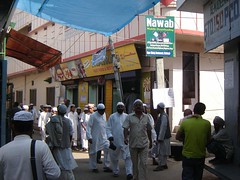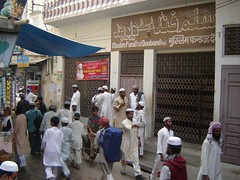Deoban series- first part
Deoband is on the world map thanks to a famous institution that was established here in 1866. Manzar Bilal of TwoCircles.net, a Darul Uloom’s graduate visited Deoband recently to give us a glimpse of life in this city and its famous madrasa. First part of the seven part series.
By Manzar Bilal TwoCircles.net,
Famous for all the wrong reasons, Deoband is a city in the district of Saharanpur, Uttar Pradesh. It is located at about 150 km North of Delhi. Deoband used to be surrounded by thick forests called Devi Van, or ‘the Forest of the goddess’ and with the passage of time it became Deoband.

Deoband is one of the ancient cities in the country. Maulana Zulfiqar Ali counted it in his book among those towns which came up after the deluge of Noah. The presence of Muslims in the city is since early 13th century. According to the census of 2001, the city has a population of 1, 61,706. Muslims constitute 65% of the population. It has an average literacy rate of 70%.
There are hundreds of mosques in the city. Some of them were built during the Delhi Sultanate and Mughal rule. Masjid Qila reminds us of the time of Sultan Sikander Lodhi (1488-1517 A.D.), Masjid Khanqah came up during the regime of Akber (1555-1605 A.D.) and Masjid Abul Ma’li during the reign of Aurungzeb (1657- 1706 A.D.).
Deoband is on the world map because of Darul Uloom, one of the most important and influential schools of Islamic Studies. It is best known all over the world for contribution of great Islamic scholars and authorities of Islamic jurisprudence and also for the centre of publication of books and publishing houses. The adjoining areas of Deoband have a large number of relics and tombs of great figures of Islamic history of the Indian subcontinent.
Besides Darul Uloom, Deoband has several other educational institutions. Among those- Darul Uloom waqf, Madrsa Asgharia, Jamia Imam Anwer, Jamia Tibbiya, College of Unani Medicine, Inter College, Tehsil School, Islamia Higher Secondary School, Sanskrit Mahavidyalaya, Public School, Vidya College, B.ED College and Madani Technical Institute deserve special mention.
When you get down from the train at Deoband station, you will be welcomed by rickshaw-wallahs crying ‘Darul Uloom, Darul Uloom, Darul Uloom’ and sometimes your luggage will be snatched and a rickshaw selected for you. When you sit on the rickshaw, they will drive it so fast in narrow streets that if you are new you will be scared but fear not as they are the experts.

After some minutes traveling by rickshaw from the station you will reach Tehseel office where the main market of the city called ‘Mina Bazar’ is located. Here you will find both Muslims and non-Muslims shopkeepers sitting in their shops. From right here you will encounter a sea of young men with skull caps. These are Madarsa student who have come to market for their needs.
When you proceed further, you will see a number of book stalls, publishing houses and shops of other things related to education on both sides of road where daily students of madrasas throng. Books worth of lakhs of rupees are dispatched every day from here to different part of the country as well as abroad. Presence of thousands of student not only of Darul Uloom but also of a large number of madarsas patronize several garment shops, hotels and tea stalls providing business opportunity to residents of the area.
Though Deoband is a world famous town and it has succeeded in drawing people form across the global still it is not a developed city though for the last few years it is getting better. Many new colonies are coming up. The pucca roads have been constructed from streets to streets and some parks are also built where people can take in fresh air but there is a lot to do concerning hygien and cleanliness as you will find garbage on the roads at several places including near Darul Uloom.
If you go to other side of the city, there are bus halts, hospitals, banks, telephone exchange and offices. This is Muzaffarnagar-Saharanpur road, which divides the area into Muslim and Hindu majority population on either side of the road.

Thanks to the Muslim population, Muslims have been occupying the chairman post of the municipal board of the city. Years back, late Maulana Habibur Rahman Usmani, the ex-rector of Darul Uloom was the chairman for several years and now it is headed by Maulana Haseeb Siddiqi who is a product of Darul Uloom.
“Muslims are financially in moderate position in the city as by the virtue of many educational centres literacy rate is good here but there are also a number of those who are working on daily wage and pulling rickshaws” said Nadeemul Wajdi, editor of Urdu monthly Tarjuman-e-Deoband.
“Muslims and Hindu are living here have friendly relations and they are busy in their own works. Some years back Praveen Togadia visited the city and try to spread the poison of communal tension but local Hindus did not give him positive response. Hence, the environment of the city remained calm and peaceful” he added.
Noted Urdu journalist and grandson of Allama Anwar Shah Kashmiri, Maulana Azhar Shah Qaiser said: “This historical city has been an example of communal harmony. In 1992 when violence spread out in several parts of the country a student was gunned down by police as he came out of Madarsa campus which angered the students but administration of Darul Uloom controlled them. In my opinion, it is because Muslims and Hindu are living in almost separate areas and also it is a place of Sufi saints and religious personalities who always made efforts for the cause of good relation between the communities.”

